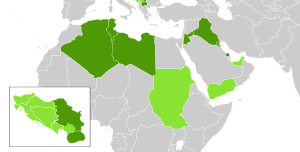Thedinar(/dɪˈnɑːr/) is the name of the principalcurrencyunit in several countries near theMediterranean Sea,with a more widespread historical use. The English word "dinar" is the transliteration of theArabicدينار (dīnār), which was borrowed via theSyriacdīnarā,itself from theLatindēnārius.[1][2]

Themodern gold dinaris a projectedbulliongold coin,and as of 2019[update]is not issued as an official currency by any state.
History
editThe modern dinar's historical antecedents are thegold dinarand thesilver dirham,the main coin of the medievalIslamic empires,first issued inAH77 (696–697 AD) (Late Antiquity) byCaliphAbd al-Malik ibn Marwan.The word "dinar" derives from the Latin word "dēnārius,"a silver coin ofancient Rome,which was first minted about c. 211 BC.
TheKushan Empireintroduced a gold coin known as thedīnārain India in the 1st century AD; theGupta Empireand its successors up to the 6th century adopted the coin.[3][4]
The 8th century English kingOffa of Merciaminted copies ofAbbasiddinars struck in 774 by CaliphAl-Mansurwith "Offa Rex" centred on the reverse.[5][6]Themoneyerlikely had no understanding ofArabicas the Arabic text contains many errors. Such coins may have been produced for trade withIslamic Spain.These coins are called aMancus,which is also derived from theArabic language.[7]
Legal tender
editCountries with current usage
editCountries currently using a currency called "dinar" or similar:
| Countries | Currency | ISO 4217code |
|---|---|---|
| Algeria | Algerian dinar | DZD |
| Bahrain | Bahraini dinar | BHD |
| Iraq | Iraqi dinar | IQD |
| Jordan | Jordanian dinar | JOD |
| Kuwait | Kuwaiti dinar | KWD |
| Libya | Libyan dinar | LYD |
| North Macedonia | Macedonian denar | MKN (1992–1993) MKD (1993−present) |
| Serbia | Serbian dinar | RSD CSD (2003–2006) |
| Tunisia | Tunisian dinar | TND |
As a subunit
edit- 1⁄100of theIranian rial
Countries with former usage
editCountries and regions which have previously used a currency called "dinar" in the 20th century:
| Countries | Currency | ISO 4217code | Used | Replaced by |
|---|---|---|---|---|
| Abu Dhabi | Bahraini dinar | BHD | 1966–1973 | United Arab Emirates Dirham |
| Republic of Bosnia and Herzegovina | Bosnia and Herzegovina dinar | BAD | 1992–1998 | Bosnia and Herzegovina convertible mark |
| Croatia | Croatian dinar | HRD | 1991–1994 | Croatian kuna |
| Iran | Iranian rialwas divided into at first 1250 and then 100 dinars | |||
| South Yemen | South Yemeni dinar | YDD | 1965–1990 | Yemeni rial |
| Yemen | 1990–1996 | |||
| Sudan | Sudanese dinar | SDD | 1992–2007 | Sudanese pound |
| Kingdom of Yugoslavia SFR Yugoslavia FR Yugoslavia |
Yugoslav dinar | YUF (1945–1965) YUD (1965–1989) YUN (1990–1992) YUR (1992–1993) YUO (1993) YUG (1994) YUM (1994–2003) |
1918–2003 | Serbian dinar |
See also
editReferences
edit- ^Oxford English Dictionary,Second edition, 1989,s.v."dinar"; online version November 2010
- ^Versteegh, C. H. M.; Versteegh, Kees (2001).The Arabic Language.Edinburgh University Press. p. 60.ISBN978-0-7486-1436-3.
- ^Friedberg, Arthur L.; Friedberg, Ira S. (2009).Gold Coins of the World: From Ancient Times to the Present.Coin & Currency Institute. p. 457.ISBN978-0-87184-308-1.
- ^Mookerji, Radhakumud (2007).The Gupta Empire.Motilal Banarsidass. pp. 30–31.ISBN978-81-208-0440-1.
- ^"Coin | British Museum".
- ^Medieval European CoinageArchived2023-08-12 at theWayback Machineby Philip Grierson, p. 330.
- ^"THE GOLD" MANCUS "- jstor".
External links
edit- Krause, Chester L.; Clifford Mishler (2003).2004Standard Catalog of World Coins:1901–Present.Colin R. Bruce II (senior editor) (31st ed.). Krause Publications.ISBN0873495934.
- Malaysia: Kelantan collects Zakat in Shariah money